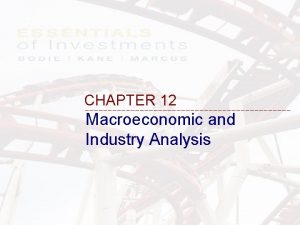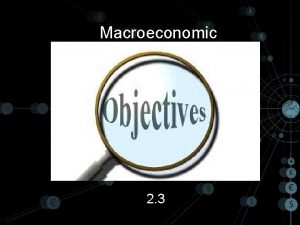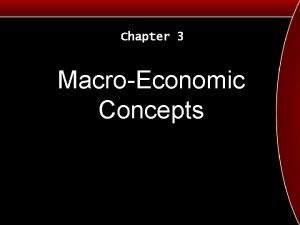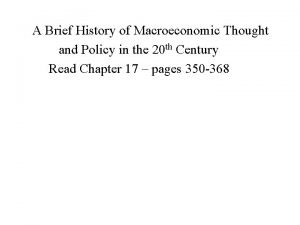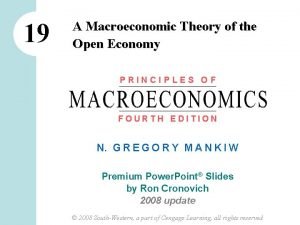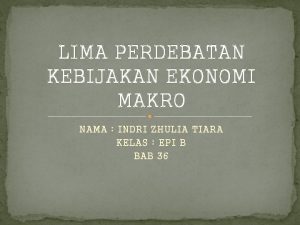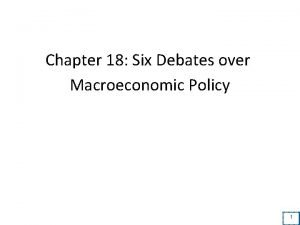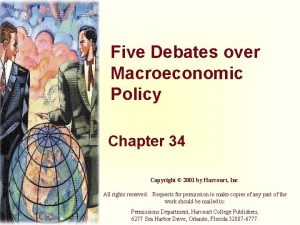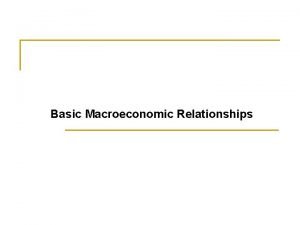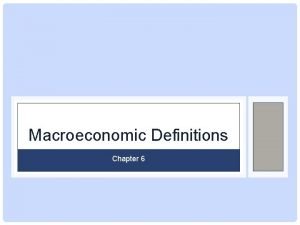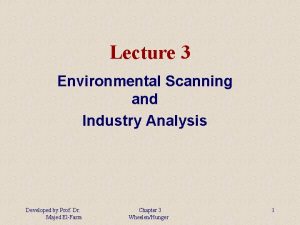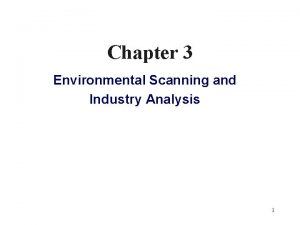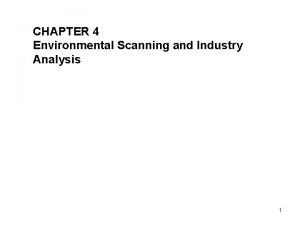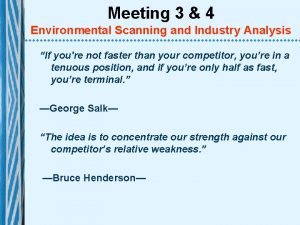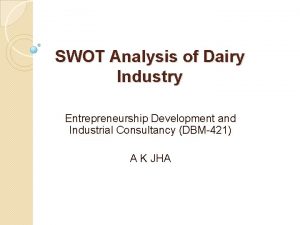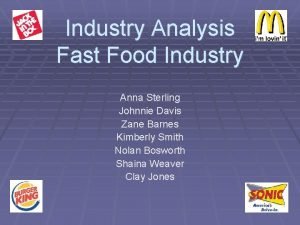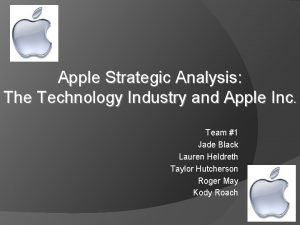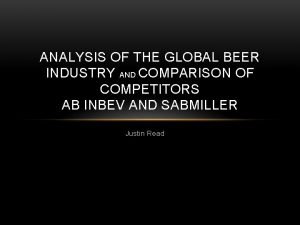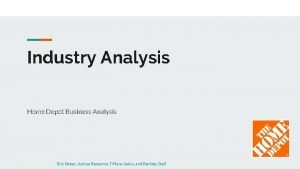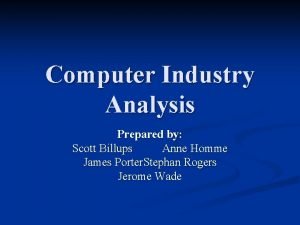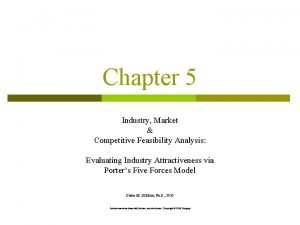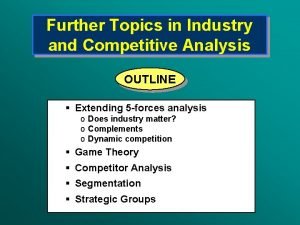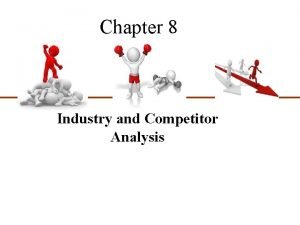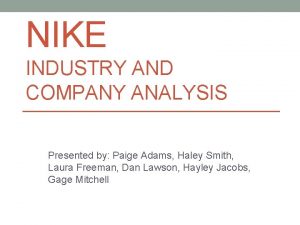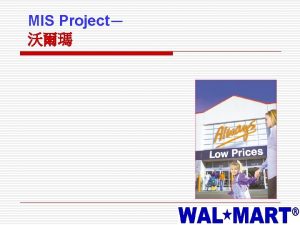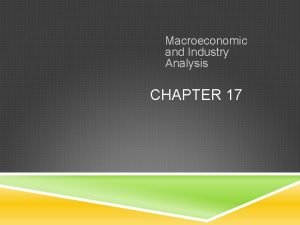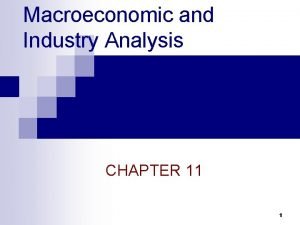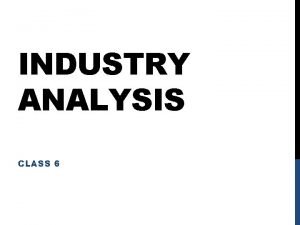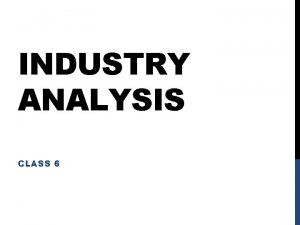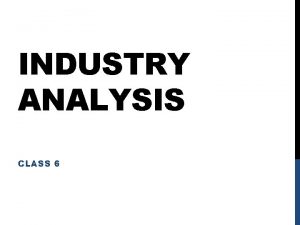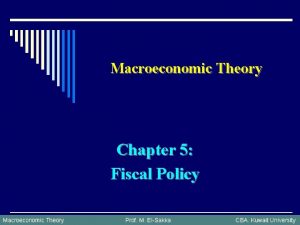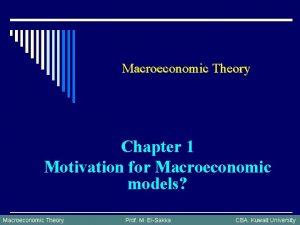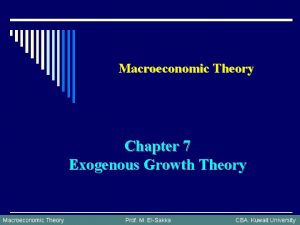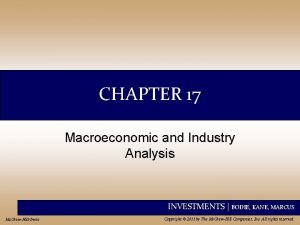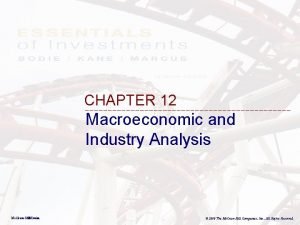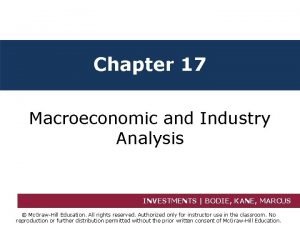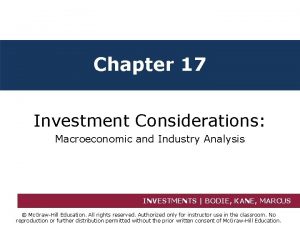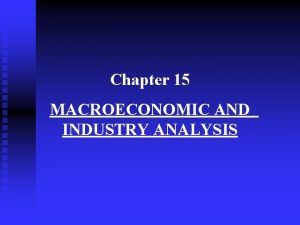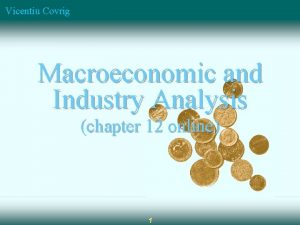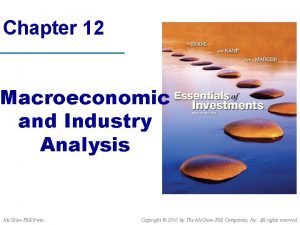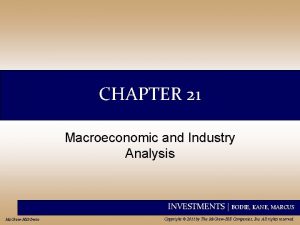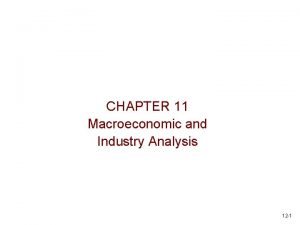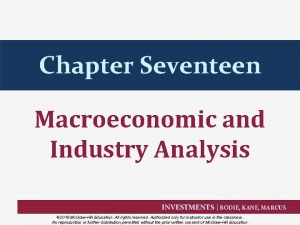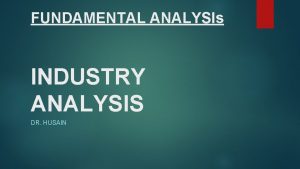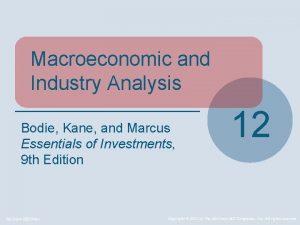CHAPTER 12 Macroeconomic and Industry Analysis Framework of






















































- Slides: 54

CHAPTER 12 Macroeconomic and Industry Analysis

Framework of Security Analysis (證券分析) (or Fundamental analysis (基本分析)) – The analysis to determine firm values, by predicting earnings and dividends with publicly economic and accounting information Three levels of security analysis – Global and domestic economic analysis (Ch 12) – Industry analysis (Ch 12) – Company analysis (equity valuation in Ch 13 and financial statement analysis in Ch 14) Why use the top-down sequence – Macroeconomic and industry circumstances might have a greater influence on profits than the firm’s relative competitiveness within its industry 12 -2

The Goals of Chapter 12 International economic analysis (國際經濟分析) and the exchange rate risk Domestic economic analysis (本國經濟分析) – Introduce key domestic economic variables – Analysis of demand supply shocks – Fiscal and monetary policies (財政與貨幣政策) – Business cycle analysis (景氣循環分析) Industry analysis (產業分析) – Sensitivity of industry performance to business cycle – Sector rotation strategy (產業輪動策略) – Life cycles of an industry (產業生命週期) ※ 本章主要介紹可觀察那些變數來分析「各國或是國際間的經濟情況」和 「整體與產業景氣循環」。但在效率市場,資產價格已經反映這些變數, 唯有做出比其他交易者更準確的預測,才能賺到超額的報酬 12 -3

12. 1 THE GLOBAL ECONOMY 12 -4

Global Economic Analysis International economic risks (國際經濟風險) – International economy affects a firm’s export prospects, price competition with foreign competitors, profits on international investments, etc. The subprime and credit crises in 2008 -2009 The euro zone debt crisis (歐債危機) in 2010 -2011 affects many (particularly euro zone) countries – Economic performance in 2016 (see the next slide) Economies in southeast Asia had nearly double the expected GDP growth rate as those in the Eurozone In the Eurozone, German economy was forecast to expand at a rate of 1. 4%, nearly double the projected 0. 5% growth rate in Italy Stock market returns do not always align with macroeconomic expectation, e. g. , China 12 -5

Economic Performance, 2016 ※ Exchange rate risk (外匯風險): the stock market return in U. S. dollars is sometimes significantly different from that in the local currency, e. g. , Brazil and Britain 12 -6

U. S. Dollar vs. Major Currencies in Real Exchange Rate, 2003 -2016 ※ Real exchange rate is the inflation-adjusted exchange rate ※ U. S. dollar appreciated in real terms means the dollar has gained purchasing power relative to another currency ※ Goods priced in foreign currencies have become less expensive to U. S. consumers; goods priced in U. S. dollars have become less affordable to consumers abroad 12 -7

12. 2 THE DOMESTIC MACROECONOMY 12 -8

Key Economic Variables Introduce some domestic economic variables – Note that one must forecast better than other competitors to earn abnormal profits Gross domestic product (GDP, 國內生產總額) – The market value of the economy’s total production of goods and services over a period of time – Rapidly growing GDP indicates an expanding economy Industrial production ( 業生產總額) – A measure of economic activity more narrowly focused on the manufacturing side of the economy 12 -9

Key Economic Variables Unemployment rate (失業率) – (Persons are unemployed but actively seeking and willing to work) / (Total labor force) – (1 – unemployment rate) measures the extent to which the economy is operating at full capacity Inflation (通貨膨脹) – The rate at which the general level of prices is rising – High inflation rates are often associated with “overheated” economies, i. e. , the demand for goods and services exceeds productive capacity, which leads to upward pressure on prices – Trade-off between inflation and unemployment: stimulate the economy enough to maintain nearly full employment, but not so much as to bring 12 -10 inflationary pressures

Key Economic Variables Interest rates (利率) – High interest rates reduce the PV of future CFs, thereby reducing the attractiveness of investment opportunities Therefore, high interest rates could restrain the overheated economy Budget Deficits (預算赤字) – The budget deficit of the government is the difference between government spending and taxes – Any budgetary shortfall must be offset by government borrowing (through issuing T-bonds) – Large amounts of government borrowing could force up the interest rate and thus “crowd out” (排擠) private borrowing and investing 12 -11

Key Economic Variables Sentiment indicator (消費者心理因素指標) – Consumers’ and producers’ optimism or pessimism concerning the economy are important determinants of economic performance – Beliefs influence how much consumption and investment will pursued and thus affect the aggregate demand for goods and services – The consumer confidence index (CCI, 消費者信心指 數) is calculated and published in many countries (in Taiwan, the CCI survey is conducted by NCU) The P/E ratio (本益比) rule: – For S&P 500 index, the P/E ratio tends to be in the range of 12 to 25 (see the next slide) – The exact P/E ratios for market indexes vary with the above mentioned economic variables 12 -12

S&P 500 versus EPS Estimate ※ EPS is defined as the earnings per share for the S&P 500 index portfolio ※ The series of S&P 500 is almost between the series of 12 × EPS and 25 × EPS, which implies that the P/E ratio is on average in the rage of 12 to 25 12 -13

12. 3 INTEREST RATES 12 -14

Interest Rates (IRs) The level of IRs is one of the most important macroeconomic factor to be considered in one’s investment analysis – Forecasts of IRs affect present values and thus expected returns for investments (especially fixed -income investments) – For stock markets, increases in IRs tend to be bad news High IRs reduce the PVs of stock investment High IRs attract investors to deposit capital in banks (or invest in fixed-income securities offering high yields) and thus affect the incentive to invest in stocks – Forecasting IRs is one of the most difficult parts in both macroeconomics and finance 12 -15

Interest Rates (IRs) Four factors determining the IRs ※The first three factors determine the level of real interest rates (實質利率) (see Slides 12 -16 and 1217) and the last factor is the expected inflation rate ( 期望物價成長率) 1. Supply of funds from savers, primarily households Supply ↑ the supply curve is shifted to the right equilibrium real IR ↓ 2. Demand for funds from businesses Demand ↑ the demand curve is shifted to the right equilibrium real IR ↑ (from point E to point E’) 3. Government’s net supply or demand for funds Currency supply ↑ real IR ↓ (stimulate economic growth) 12 -16

Determination of the Equilibrium Real Interest Rate ※ The fund-supply curve slopes up from left to right because the higher the real interest rate, the greater the fund supply from household savings ※ The fund-demand curve slopes down from left to right because the lower the real interest rate, the more projects firms will undertake, due to the lower capital cost 12 -17

Interest Rates (IRs) 4. Expected rate of inflation Interest rates contain a premium for expected inflation The Federal Reserve typically raises interest rates proactively when inflation is expected to increase ※ To obtain the nominal interest rate (名目利率), one needs to add the expected inflation rate to the equilibrium real rate (均衡實質利率) 12 -18

12. 4 DEMAND SUPPLY SHOCKS 12 -19

Demand Shocks Demand shock (需求衝擊) – An event that affects the aggregate demand for goods and services (整體對貨物與服務的需求) – Demand could increase due to, e. g. , Reduction in tax rates Increases in the money supply, governmental spending, and foreign export demand – Positive demand shocks is usually associated with the increases of IRs and inflation rates (demand ↑ demand > supply price and thus inflation rate ↑ nominal IR ↑; or demand ↑ funds needed by firms ↑ IR ↑) Increases of demand generally implies the expansion and boom of the economy 12 -20

Supply Shocks Supply shock (供給衝擊) – An event that influences the total production capacity and costs (整體製造能力與製造成本) – Supply decreases due to, e. g. , Increases of prices of raw materials Freezes, floods, or droughts that may destroy agricultural crops Decreases in the wage rates – Negative supply shocks are usually associated with the increases of IRs and inflation rates (supply ↓ demand > supply price and thus inflation rate ↑ nominal IR ↑) Negative supply shocks result in reduced output, leading to slower economic growth 12 -21

Demand Supply Shocks How to relate the above knowledge to investment analysis? – Choose industries that will be helped by your expectation about the change of the demand supply and avoid those that will be hurt For example, positive demand shock choose the automobile or luxury producers, which benefit most from the positive demand shock (In contrast, food producers, for example, also benefit from the positive demand shock but not much) 12 -22

12. 5 FEDERAL GOVERNMENT POLICY 12 -23

Government Policy Demand-side policy – The economy will not by itself arrive at a full employment equilibrium, so macroeconomic policies are used to affect the demand for goods and services to stimulate (刺激) the economy toward this goal – Most fiscal and monetary policies introduced later are based on this demand-oriented argument Supply-side policy – The goal is to induce (引起) workers and owners of capital to have the maximum incentive and ability (動 機與能力) to produce and develop goods – For example, lowering tax rates will elicit (引出) more investment and improve incentives to work, thereby enhancing economic growth 12 -24

Fiscal Policy Fiscal policy (財政政策) – The use of government spending and taxing actions to stabilize (穩定) or spur (刺激) the economy Increases in government spending directly inflate the demand for goods and services Increases in tax rates immediately siphon (虹吸, 輸送) income from consumers and result in fairly rapid decreases in consumption – With most direct impact on the economy – However, slowly implemented because of the requirement the negotiation and compromise between executive and legislative branches So, the fiscal policy cannot in practice be used to quickly fine-tune the economy 12 -25

Fiscal Policy – Government’s budget deficit or surplus: Tax income < government spending budget deficit ( 預算赤字) Tax income > government spending budget surplus ( 預算盈餘) The effect of budget deficits: increase the demand for goods and services (via government spending) by more than it reduces the demand for goods and services (via taxes collection), and therefore stimulate the economy (For most nations, they adopt the budget-deficit policy to stimulate the economy) 12 -26

Monetary Policy (貨幣政策) – Manipulation of the money supply to influence economic activity – Different from the direct influence from fiscal policies, monetary policies work indirectly through their impact on interest rates (e. g. , federal funds rate) and thus on the incentive to purchase and invest – Short- and long-term monetary effects Increases in the money supply lower short-term real and thus nominal IRs, encouraging investment and consumption In the long run, it is believed that a higher money supply leads only to a higher price level (thus a higher inflation rate) and does not have a permanent effect on economic activity 12 -27 ※The stimulation/inflation trade-off is the major consideration

12. 6 BUSINESS CYCLES 12 -28

The Business Cycle Recurring patterns of recession and recovery are called business cycles (see Slide 12 -30) – Peak (高峰): The transition from the end of an expansion (擴張) to the start of a contraction (緊縮) – Trough (低谷): Occurring at the bottom of a recession just before the economy entering a recovery (expansion) Industry relationship to business cycles (cyclical vs. defensive industries) (週期性 vs. 防禦性產業 ) – Cyclical industries Industries with above average sensitivity to the state of the economy, e. g. , the producers of durable goods (e. g. , cars) or capital goods (that are used by other firms to produce 12 -29 their own products)

Four Phases of a Business Cycle 12 -30

The Business Cycle – Defensive industries Industries with below-average sensitivity to the state of the economy For example, food producers, pharmaceutical firms, and public utilities – The demand of food, drugs, electricity, and gas is consistent regardless of the business cycle Firms in defensive industries tend to have low betas – The trading strategy based on the business cycle Optimistic about the economy, hold cyclical stocks Pessimistic about the economy, hold defensive (or counter -cyclical) stocks 12 -31

Economic Indicators (經濟指標) Leading Indicators (領先指標) – economic series tend to rise and fall in advance of the economy, for example, – Stock prices (S&P 500 stock index) Stock prices are forward-looking estimates for future profitability and thus able to be a leading indicator Since the stock prices themselves are leading indicators, the information of other leading indicators contributes less for stock investment – by the time they predict an upturn, the stock market has already made its move Stock prices can be a leading indicator for the business cycle, but there is no leading indictor for stock prices – Money supply growth rate Due to the indirect and lag influence of the monetary policy on the economy 12 -32

Economic Indicators (經濟指標) Coincident Indicators (同期指標) – indicators that tend to change in tandem (一前一後地) with the economy, e. g. , – Industrial production – Manufacturing and trade sales Lagging Indicators (落後指標) – indicators that tend to rise or fall behind the rest of the economy, e. g. , – Ratio of inventories to sales (high inventories suggest the economy is in recession) – Ratio of consumer installment credit (消費者分期付 款信貸) outstanding to personal income Cyclical indicators are summarized on Slide 12 -3412 -33

Economic Indicators (經濟指標) 12 -34

Economic Indicators ※ The shaded areas represent periods of recession ※ The dates at the top of the chart are formatted as year: month 12 -35

Economic Calendar ※ A wide range of economic indicators are released to the public on a regular “economic calendar” 12 -36

Economic Calendar ※ The recent “forecasts” of each variable are provided along with the “actual” value of each statistic ※ In an efficient market, security prices already reflect market expectation, so only the new information in the announcement will determine the market response 12 -37

12. 7 INDUSTRY ANALYSIS 12 -38

Industry Analysis The industry analysis (產業分析) is as important as the macroeconomic analysis because it is unusual for a firm in a troubled industry to perform well Performance of return on equity (ROE) varies across industries (see Slide 12 -40) – ROEs can range from 0. 9% for the iron and steel industry to 24. 6% for the aerospace industry – ROEs of firms in the same industry, e. g. , application software, also varies substantially Stock price performance also varies a lot for different industries (see Slide 12 -41) 12 -39

Returns on Equity ※ ROEs for different industries in late 2016 ※ ROEs for firms in application software industry on June 8, 2017 12 -40

Industry Stock Price Performance, 2013 vs 2016 2013 2016 Electric utilities Money center banks Heavy construction Auto manufacturers Tobacco Application software Aerospace/defense Asset management Pharmaceuticals Home improvement Restaurants Major airlines -10 10 30 50 Rate of return (%) 70 90 ※ In 2013, stock prices of different industries perform diversely ※ In 2016, there are 20 of the 22 industries showing a positive return, a testament to the significant influence of some systematic factors on stock prices 12 -41

Defining an Industry Where to draw the line between one industry and another – North American Industry Classification System (北 美產業分類系統) or NAICS Codes There are codes assigned to group firms for statistical analysis (see Slide 12 -43) Firms with the same 4 -digit NAICS codes are commonly taken to be in the same industry – S&P classifies firms into about 100 industry groups, and Value Line Investment Survey groups firms into about 90 industries – Industry classifications are never perfect For example, both Kohl’s (high-volume “value” store) and Neiman Marcus (high-margin elite retailer) might be classified as department stores 12 -42

Examples of NAICS Industry Codes ※ The first two digits define the major industry group, e. g. , NAICS code 23 = construction 12 -43

Sensitivity to Business Cycle It is interesting to see how business cycles affect the performance of specific industries Three factors affecting sensitivity of earnings (收 益敏感度) to business cycles – Sensitivity of sales (銷售敏感度) Sales of necessities will show little sensitivity to business conditions, e. g. , food, drugs, medical services Sales of luxuries or discretionary goods are more sensitive to business conditions, e. g. , jewelry, autos, recreational services Sale growths of jewelry stores vs. grocery stores on the next slide 12 -44

Industry Cyclicality ※ Sales of jewelry stores fluctuate more widely than those of grocery stores 12 -45

Sensitivity to Business Cycle – Financial leverage (財務槓桿) Since interest expenses on debt must be paid regardless of sales, they will increase the sensitivity of profits to sales Profits for high-financial-leverage industries swing more widely with sales (business cycles) – Operating leverage (營運槓桿) The degree to which the operating costs are fixed Fixed operating costs (固定營運成本) are those the firm incurs regardless of its production level; Variable operating costs (變 動營運成本) are those that rise or fall as the firm produces more or less products Fixed operating costs ↑ the costs is without flexibility with sales profits for high-fixed-costs industries swing more widely with sales (business cycles) using high fixed operating costs is equivalent to increase operating leverage ※ Note that the above inference is based on the assumption that sales are positively correlated with business conditions 12 -46

Sector Rotation (產業輪動) An investment strategy to select industries in different phases of a business cycle – Peak (高峰): invest in natural resource firms The economy might be overheated with high inflation Invest in natural resource firms to against the inflation – Contraction (緊縮): invest in defensive firms, e. g. , food, drugs, or other necessities These firms are less affected by the contraction Lower inflation and IR rates favor financial firms – Trough (低谷): invest in equipment, transportation and construction firms Firms might purchase new equipment to meet anticipated increases in demand in the following expansion – Expansion (擴張): invest in cyclical industries, e. g. , consumer durables and luxury items These firms are the most profitable in this phase 12 -47

Sector Rotation (產業輪動) ※ The typical sector rotation across different states of a business cycle is shown in the above figure ※ Each sector historically had their “day in the sun” during a typical economic cycle ※ Consumer staples (必需性消費類股); Consumer discretionary (非必需性消費類 股) 12 -48

Industry Life Cycle (產業生命週期) Stage Sales Growth Start-up (初始階段) Rapid & Increasing Consolidation (強化階段) Stable Maturity (成熟階段) Slowing Relative Decline (相對衰退階段) Minimal or Negative (Each stage will be discussed in details) 12 -49

Industry Life Cycle (產業生命週期) Start-up stage (初始階段) – The early stages of an industry are often characterized by a new technology or product, e. g. , PC in the 1980 s, smart phone since 2007 – At this stage, sales and earnings grow at an rapid rate since the new product has not yet saturated in market Consolidation stage (強化階段) – The industry survivors and leaders begin to emerge – The performance of the surviving firms will closely track the performance of the overall industry – The industry will grow faster than the rest of the economy 12 -50

Industry Life Cycle (產業生命週期) Maturity stage (成熟階段) – The product is used extensively in the market – The product has become far more standardized – There is price competition among firms in the industry – Firms at this stage are called as “cash cows, ” which are with stable CF but offering little opportunity for profitable expansion Relative decline stage (相對衰退階段) – The industry might grow as less than the rate of the overall economy, or it might even shrink – This could be due to the product being out of date or the competition from new products 12 -51

Industry Life Cycle (產業生命週期) The logic behind the necessary progression from one stage of the industry life cycle to the next – High growth and fat profits bring new competitors and thus generate new sources of supply to reduce prices, profits, and growth finally Are high-growth industries good investment targets? – The historical records tells us they are, as long as they offer high enough expected return to compensate the risks you bear – But if the security prices already reflect the likelihood for high growth, then it is too late to make money from this strategy 12 -52

Industry Competition and Structure A highly competitive industry must has lower profit margin and thus is not a good investment target Five determinants of competition: – Threat of entry New entrants to an industry pressure prices/profits First mover advantage (先驅者優勢), entry barriers (進入障 礙), brand loyalty (品牌忠誠度), proprietary knowledge (專 有資訊) or patent (專利) can reduce threat – Rivalry (對抗競爭行為) between existing competitors Market share competition pressures prices/profits Slow industry growth and homogeneity of goods exacerbate (使惡化) the decline in prices/profits Often occurs in the maturity stage 12 -53

Industry Competition and Structure – Pressure from substitute products (替代產品) in related industries Sugar vs. corn syrup (玉米糖漿), Wool vs. synthetic fiber ( 人造纖維) Limit the prices of products – Bargaining power of buyers Large-scale buyers have considerable bargaining power For example, auto producers can put pressure on supplier of auto parts and thus reduce the profits of the auto parts industry – Bargaining power of suppliers Large-scale suppliers have considerable bargaining power and can demand higher prices for the good of the industry Bargaining power of suppliers also depends on the availability of substitute products 12 -54
 Macroeconomic and industry analysis
Macroeconomic and industry analysis Macroeconomic objectives
Macroeconomic objectives Five debates over macroeconomic policy
Five debates over macroeconomic policy Short run macroeconomic equilibrium
Short run macroeconomic equilibrium Macroeconomics deals with
Macroeconomics deals with History of macroeconomic thought
History of macroeconomic thought A macroeconomic theory of the open economy
A macroeconomic theory of the open economy Six debates over macroeconomic policy
Six debates over macroeconomic policy Six debates over macroeconomic policy
Six debates over macroeconomic policy 5 debates over macroeconomic policy
5 debates over macroeconomic policy Five debates over macroeconomic policy
Five debates over macroeconomic policy Basic macroeconomic relationships
Basic macroeconomic relationships Macroeconomic definitions
Macroeconomic definitions Industry and competitor analysis
Industry and competitor analysis Conceptual framework definition
Conceptual framework definition Environmental scanning and industry analysis
Environmental scanning and industry analysis Environmental scanning and industry analysis
Environmental scanning and industry analysis The corporation's task environment
The corporation's task environment Environmental scanning and industry analysis
Environmental scanning and industry analysis Dispositional framework vs regulatory framework
Dispositional framework vs regulatory framework Conceptual framework
Conceptual framework Theoretical framework
Theoretical framework Dispositional framework vs regulatory framework
Dispositional framework vs regulatory framework Theoretical framework
Theoretical framework Chapter 18 industry and urban growth
Chapter 18 industry and urban growth Swot analysis for game development
Swot analysis for game development Swot analysis of milk industry
Swot analysis of milk industry Sumwear
Sumwear Industry analysis in business plan
Industry analysis in business plan Key success factors fast food industry
Key success factors fast food industry Industry analysis
Industry analysis Chapter 7 business plan sample
Chapter 7 business plan sample Industry analysis in business plan
Industry analysis in business plan Industry analysis of apple
Industry analysis of apple Pestel analysis beer industry
Pestel analysis beer industry Best buy swot
Best buy swot Indian plastic industry analysis
Indian plastic industry analysis Industry analysis definition
Industry analysis definition Home depot industry analysis
Home depot industry analysis Swot analysis of mice industry
Swot analysis of mice industry Scott billups
Scott billups Industry analysis in feasibility study
Industry analysis in feasibility study First screen feasibility analysis
First screen feasibility analysis American apparel target market
American apparel target market Industry analysis outline
Industry analysis outline Competitive analysis outline
Competitive analysis outline Industry/target market feasibility analysis example
Industry/target market feasibility analysis example Strategic industry analysis
Strategic industry analysis Objective of industry analysis
Objective of industry analysis Swot analysis of textile industry in pakistan
Swot analysis of textile industry in pakistan Nike company analysis
Nike company analysis Physical therapy industry analysis
Physical therapy industry analysis Under armour industry analysis
Under armour industry analysis Walmart intranet
Walmart intranet El taco rico austin
El taco rico austin
